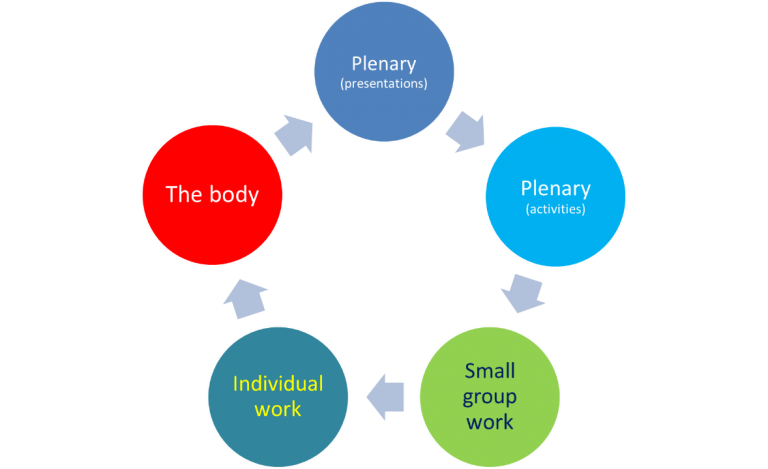Since the previous global crisis in 2008, we have been developing virtual classroom training as a team. Through trial & error, step by step, we have found out what works well and what is not a good idea when working with a group in virtual space. Gradually, we refined our training model and found that a 2-hour session works best in most cases. Knowing that attention span is much lower in virtual space than in a F2F setting (something that is changing due to social media use, but that’s another story…) we found that it works well to keep a group productively engaged through activities, exercises, breakout groups, etc. for about one hour. After these 60 minutes, we give attention to the physical side: the body. It is essential to change the body posture: from sitting looking at a screen to standing up, moving around briefly and attending to physical needs such as thirst, hunger and going to the lavatory. There is abundant research highlighting the importance of ‘micro-breaks’ for vigilance and health.

Now, in the middle of another much larger global crisis, we see a much more widespread shift of training, workshops, conferences, etc. to live online sessions. Whether we like it or not, the Corona pandemic has forced us to be creative in finding new ways of working remotely. Many organisations are suddenly moving events from F2F to online, including longer sessions, such as 8-hour training days and large scale conferences. In this article, we’ll take a look at training sessions that go well beyond the 2-hour model that we had adopted and polished.
We have found that longer days in the virtual classroom work surprisingly well, as long as you adhere to the same design criteria as defined for shorter session (we talked about it before).
What’s different in longer training sessions is the rhythm of moving between plenary, small group work and individual work and physical needs. We have differentiated 5 modalities as show in this graph:

Below you can see a sample windowpane for an 8-hour training day in the virtual classroom, typically with a group of 12-15 participants. Look at the right-hand column in particular for the rhythm between the 5 learning modalities. What strikes you about this design?


Nomadic IBP facilitators are available to help you shift your training sessions, workshops and conferences from a F2F setting into an online one.

Fredrik Fogelberg is a chartered Organisational Psychologist specializing in leadership development and team facilitation in international organizations. He has over 30 years of international experience in the corporate world and as a consultant.


